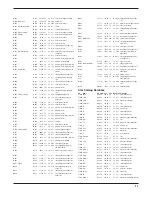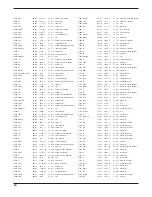
4
determine the correct ratios if using gears, divide 2048 into the
encoder resolution (4000 for the larger high resolution, 2160
for the smaller standard resolution). Then multiply that number
by the number of teeth on the encoder gear and divide by the
number of teeth on the telescope axis gear. For example, if
using a High Resolution (4000 step) encoder with a 84 tooth
gear connected to it and the telescope axis has a 96 tooth
gear attached to it, the ratio would be 2048/4000 X 84/96 =
0.4480. It is common to determine the encoder polarity (+/-) by
trial and error using Encoder Direction Test.
Encoder Direction test
The purpose of the encoder direction test is to make sure the
encoders are set to the correct polarity, correct ratios, and that
nothing is slipping. You must do this test at home before trying
the Sky Wizard at night. It is the last step in the installation
procedure before going out into the field. If you find that your
Sky Wizard is way off, you must do this test before calling for
assistance.
Equatorial Telescopes: Point the telescope up and slightly
toward the South so that the Dec. is at 0 deg. on the original
(mechanical) setting circles. Rotate the original RA (mechanical)
setting circles so that RA = 00. Turn the Wizard off, then back on
to clear the Wizard and press ENTER after the Wizard reads
DEC=0. Press MODE and scroll to ENC TEST mode. Press
ENTER and it should read
000 +000.
Move the declination axis to 90° north. The display should
now show
“000 +090” if the dec axis “sign” is correct. If not,
re-enter the I
NSTALL mode and change the sign to negative
for the DEC axis (
2). If the second numerical value is not
+090, then the encoder ratio is incorrect. Check your
Installation Instructions to see if you have inputted the correct
encoder ratios in the
INSTALL Mode.
To check the RA axis, again point the telescope up and slightly
toward the South so that the Dec. is at 0 deg. on the original
(mechanical) setting circles. Rotate the original RA (mechani-
cal) setting circles so that RA = 00. Turn the Wizard off, then
back on, to clear the Wizard and press ENTER after the Wizard
reads
DEC=0. Press MODE and scroll to ENC TEST mode.
Press ENTER and it should read
000 +000. Move the telescope
toward the Western Horizon so that the RA= 18 Hrs. and it
should read
090 +000. If it reads another value, such as 270
+000 then go back to the INSTALL and change the +/- sign and
repeat the test. If you get any other values, check the encoder
ratios in
INSTALL mode. Also check that the encoder and hard-
ware are properly installed. Make sure all setscrews are tight.
Altazimuth telescopes: Turn on Sky Wizard and position the
telescope vertically as requested by the instrument in
AV (tele-
scope type) or horizontal in
AZ. Press ENTER then the MODE
button. Scroll to the
ENC TEST mode to display encoder angle.
In
AV mode tilt the altitude axis down approximately 45° from
vertical. Move it up 45 deg. in
AZ. Check that the display shows
“000 +045.” If the display is in agreement with the telescope
position, then the altitude encoder polarity is correct and no
change to the gear ratio is required. If not, press the MODE but-
ton, scroll to
INSTALL, press ENTER. Repeat the Install
procedure until you get to 2. Then change the + sign to a - sign.
Be sure to go all the way through the install mode until the word
INSTALL reappears to update the changes.
Press the MODE button and scroll to
ENC TEST and press
ENTER. Move the telescope about the azimuth bearing from
North towards East. The azimuth should increase from 0° to
90° (first numbers) if you rotate the telescope 90° to the East.
The display should now read
“090 -045,” where the 45° is from
the test of the altitude axis. If the values are off, check the
encoder ratios in the
INSTALL mode. Make sure the encoders
and hardware are installed correctly. If the
AZ is off, make sure
the bottom bolt is NOT rotating. A drop of “super glue” on the
very bottom bolt and washer will help (applied from the bottom,
NOT top). If the ALT is off, make sure the altitude bearing is
rigid. If the display is in agreement with the telescope position,
then the altitude encoder polarity is correct and no change to
the gear ratio is required. If not, press the MODE button, scroll
to I
NSTALL, press ENTER. Repeat the Install procedure until
you get to 1. Then change the + sign to a - sign (or vice versa).
Be sure to go all the way through the install mode until the word
INSTALL reappears to update the changes.
startup index Mark
Once you have finished running
INSTALL to tell Sky Wizard
about your telescope, there is one final step which need only be
done one time. As mentioned in the SETUP command, you will
see that your telescope mount needs to be aimed to a particular
position once each time you set up to observe. The accuracy of
Sky Wizard is dependent upon your accurately setting the initial
index mark, so take your time just this once!
Equatorial Mounts. If your telescope has an Equatorial Mount
with mechanical setting-circle dials, these will do nicely. First,
verify that the declination setting circle is accurately set by aim-
ing your telescope to 90° declination (telescope aimed up the
polar axis). Rotate the telescope in Right Ascension and look
for any tube “wobble.” You can verify this by looking through an
aligned finder to see that stars rotate around the middle of the
field of view. If necessary, adjust the tube so there is no wobble
and reset the setting-circle to 90°.
Another method for Fork Mounted Equatorial telescopes is to
check the Dec. setting circle using a bubble level. This should
be done inside using a carpenter’s level, before going out into
the field. Take the telescope off the wedge and put it on a level
surface. Make sure the drive base is level and the telescope
is pointed straight up with the corrector end away from the
drive base and the Dec. = 90. Place the level across the front
of the corrector cell, perpendicular to the fork arms. Adjust the
Dec. slow motion until it is level. Adjust the Dec. setting circle
to read exactly 90.
German-type Equatorial Mounts. These mounts have two
possible positions for the 0° declination setting required during
initialization. It is important to use the correct one, or the encod-
er sensing will be backwards. The telescope should be aimed
generally EASTWARD when the declination is set to 0°.
Determine which of the two zero degree index marks corre-
sponds to this direction, and place an indicating mark there for
future use. You can confirm the setting circles are accurate by
pointing the telescope exactly North. Rotate the telescope in RA















